The Museum Collections
Introduction
I. History and Art Collection
1. Icons of the 14th – 19th centuries
icons of the 14th – 17th century
2. Jewelry art of the 14th – 20th century
jewelry art of the 14th – 17th century
jewelry art of the 18th – 19th century
the european silver 14th - 19th centuries
3. Small-size sculptures (works of metal, wood, bone)
XI – the beginning of the XX century
Small-size sculptures 11th – 17th century
Small-size sculptures 18th – early 20th century
enamel of Troitza masters 15-8th – early 20th century
5.Embroidery, lace, textiles of the 14th - early 20th century
icon and ornamental embroidery
gold and silver lace
6.Painting of the 18th – 21st centuries
painting of the 18th – 19th centuris
painting of the 20th – 21st centuris
II.Manuscripts and old printed books of the 14th – 17th century
IV.Lithography of the 18th – 19th century
V.Numismatics
VI.Medals of the 18th - early 20th century
VIII.Archeology collection
IX. Russian folk and applied and decorative art of the 17th – 21st c.
1. Artistic wood
folk carved and painted wood
wooden toys
house carving of Sergiev Posad
Khokhloma and Gorodets painting
2. Artistic textiles
embroidery and weaving
printed textiles and lace
Russian shawls
folk costumes
folk garments
printed cotton kerchiefs
|
Icon and Ornamental Embroidery of the 14th – 19th Centuries (page 3) |
Ornamental Embroidery
Alongside with icon embroideries the exhibition presents interesting samples of ornamental embroidery. They are mainly church vestments, icon-cloths and purificators decorated with ornamental compositions of gold and silver threads, pearls and precious stones. The earliest specimen in the Museum collection is the liturgical cuff depicting “The Annunciation” of the late 15th century. It originated in the Grand Princess workshop of Sophia Paleologus. The ornament played a modest role at that time. It framed the embroidered composition. Its main motif was a stylized bindweed.
The 16th century works are most interesting. Among them there are outstanding samples made in the royal and famous princely and boyar workshops of Moscow. The phelonion, connected with the name of prince Pyotr Shchenyatev, is very attractive. Its shoulder-piece consists of several embroidered fragments of female attire, so it gives an idea of lay embroidery in the first place. The embroidered ornament – the tree “protected“ by animals and birds – is referred to the most ancient motifs. The ornament treatment and the pattern character are greatly influenced by folk art and folk tastes. There is hardly another work, reflecting in detail the traditional zoomorphic world – deer, horses, geese – of Russian folk embroidery.
In the mid-16th century, there appeared embroideries with floral and geometric patterns. Practically all of them date back to the middle and second half of the 16th century. They are mainly icon-cloths. The icon-cloth, donated by Anastasia Romanovna in 1550, is most important. “The Pearl Icon-Cloth” of 1599 demonstrates principal features of ornamental embroidery of the late 16th century: luxurious materials, combination with jewelry art, complicated and colorful compositions. Its decorativeness is ensured by numerous pearls and gold plaques, as well as, by multi-colored precious stones. On the one hand, Godunovs’ embroideries completed the development of ornamental embroidery in the 16th century, on the other hand, they opened a new period of fine colorful patterns of the 17th century.
|

Phelonion. 1544; 17th century. Shoulder-piece – donation of prince Pyotr Shchenyatev |
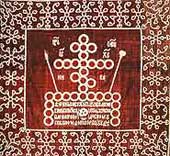
The Golgotha Cross. Icon-cloth. 1550. Donated by tsarina Anastasia Romanovna |

The Golgotha Cross. Pearl icon-cloth. 1599. Donated by tsar Boris Feodorovich Godunov
|
The 17th century ornamental embroidery is richly represented in the Museum collection. Numerous pearls drawing the pattern, so to say, and plaques of different shapes, imitating flowers and leaves, remained principal decorative materials. In the 17th century the ornaments on the shoulder-pieces and cuffs of liturgical vestments were just decorative, occasionally including elements of feudal symbols: snow-leopards, two-headed eagles and fancy birds. The characteristic sample is the phelonion with the shoulder-piece of embroidered details from a female attire, presented to the Trinity-St. Sergius Monastery in 1635 by Maxim, an archpriest of the Annunciation Cathedral and a confessor of tsar Mikhail Romanov. The exquisite embroidered pattern is emphasized by glittering pearls and mat bullion.
The sticharion of Turkish brocaded velvet with the shoulder-piece embroidered in pearls and gold and silver threads dates back to the same period. Among the samples of the last quarter of the 17th century there are few precisely dated works and all of them are of different character. The epitrachelion of red velvet, embroidered in a pearl thread combined with gold plaques, small garnets and turquoises, is typical. At that time they used the ornamental patterns of the 16th century. One of the most characteristic compositions was used in the vexillum, donated by boyarynia S.S. Morozova in 1667.
|
|
|
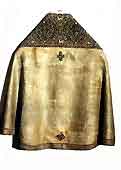
Phelonion. 1630s. |

Sticharion. 1635, 1646. |
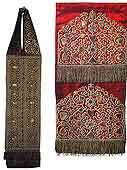
Epitrachelion. Mid-17th century. Vexillum. 1667.
Donated by boyarynia Stephanida Semyonovna Morozova
|
|
The ornamental embroideries of the last three decades of the 17th century are rather interesting. They are marked by rich, colorful and complicated floral patterns. The colorful compositions are emphasized by numerous studs with multi-colored stones, enamel, golden spangles. All decorative elements corresponded to optimistic spirit of the 17th century Russian art.
Boyar A.S. Shein’s donations give an idea of a boyar workshop, where the needlewomen could use a great deal of techniques in pearl, gold and silver thread embroidery. At the late 17th century new trends in ornamental embroidery could be traced. They are brightly manifested in the phelonion shoulder-piece embroidered between 1674 – 1697. The effect of its decorative composition was achieved by the magnificent design and multi-colored stones in gold studs, as well as, by the new function of pearls. Through the whole medieval period great attention was paid to floral ornaments, once connected with Slavonic pagan symbols of plant fertility.
|
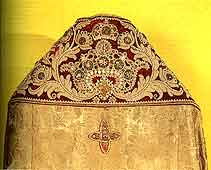
Phelonion. Last quarter of the 17th century. Detail |
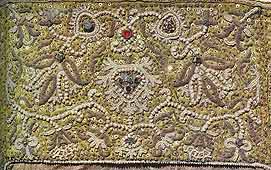
Aer. 1674. Detail. Donated by Princess Anna Vasilyevna Cherkasova
|
|


